
Heavy Rains to Continue in Telangana for Five Days
The India Meteorological Department (IMD) has forecast continuous rainfall across Telangana over the next five days. The rain activity is expected to intensify in several parts of the state, including Hyderabad, due to the presence of a low-pressure system over central India.
Heavy to very heavy showers, accompanied by thunderstorms and gusty winds, are likely to continue until July 25, affecting daily life and transportation in urban and semi-urban areas.
Districts Under Rain Watch
Districts including Hyderabad, Medchal-Malkajgiri, Sangareddy, Rangareddy, Mahabubabad, Nalgonda, and Medak are expected to receive moderate to heavy rainfall each day. Isolated locations in these districts may experience very heavy rainfall, with daily accumulation possibly crossing 100 mm.
This could result in waterlogging, flash floods in low-lying areas, and damage to temporary structures or agricultural fields in vulnerable zones.
Traffic and Civic Impact
Hyderabad has already seen traffic disruptions, overflowing drains, and power outages in pockets due to sudden cloudbursts and back-to-back showers. Residents have been advised to avoid unnecessary travel during intense spells and stay indoors during lightning alerts.
The Greater Hyderabad Municipal Corporation (GHMC) is on alert to respond to complaints related to clogged drains, fallen trees, and emergency clearance work.
Yellow Alert and Safety Guidelines
The IMD has issued a yellow alert for multiple districts, warning of thunderstorms with wind speeds between 30 and 40 km/h. Fishermen have been cautioned against venturing into rough waters, and those in hilly or rural areas are urged to stay vigilant for landslides or overflowing streams.
Forecast for the Week Ahead
According to the forecast, the rainfall is expected to peak between July 21 and 23 and gradually taper off by July 25. Temperatures are expected to remain lower than usual, providing relief from the summer heat. However, the extended wet spell may impact harvesting in certain areas and increase the risk of vector-borne diseases.
Residents are encouraged to monitor weather updates and cooperate with local authorities for safety and preparedness.


















